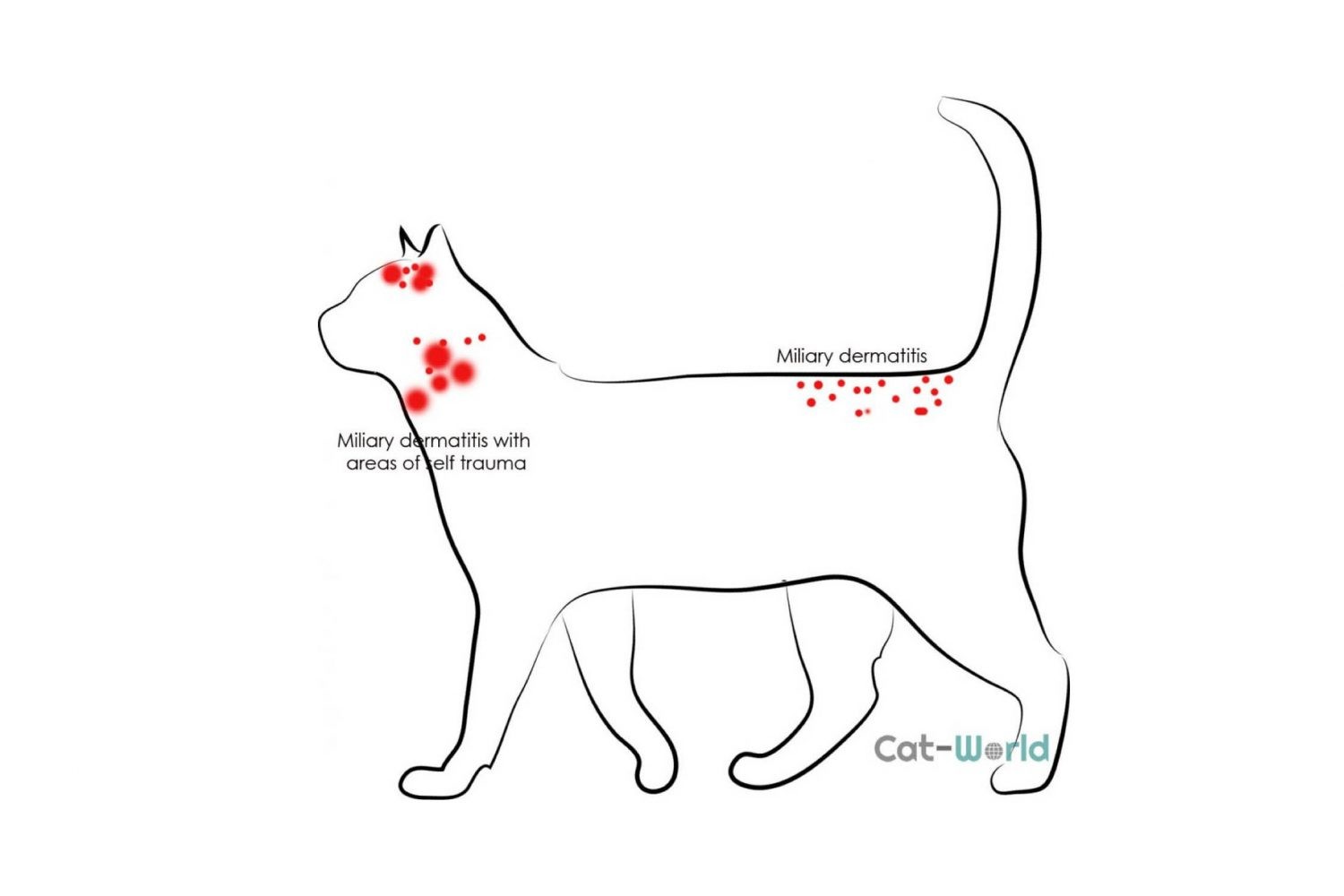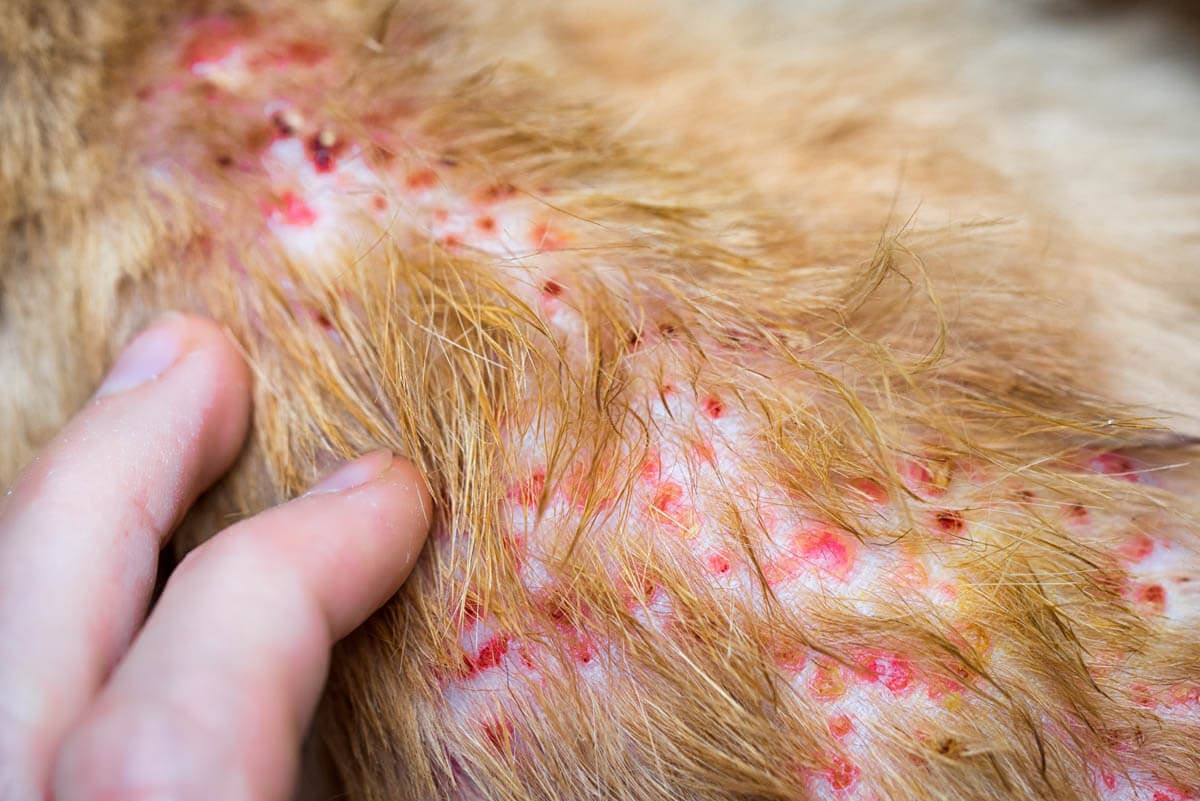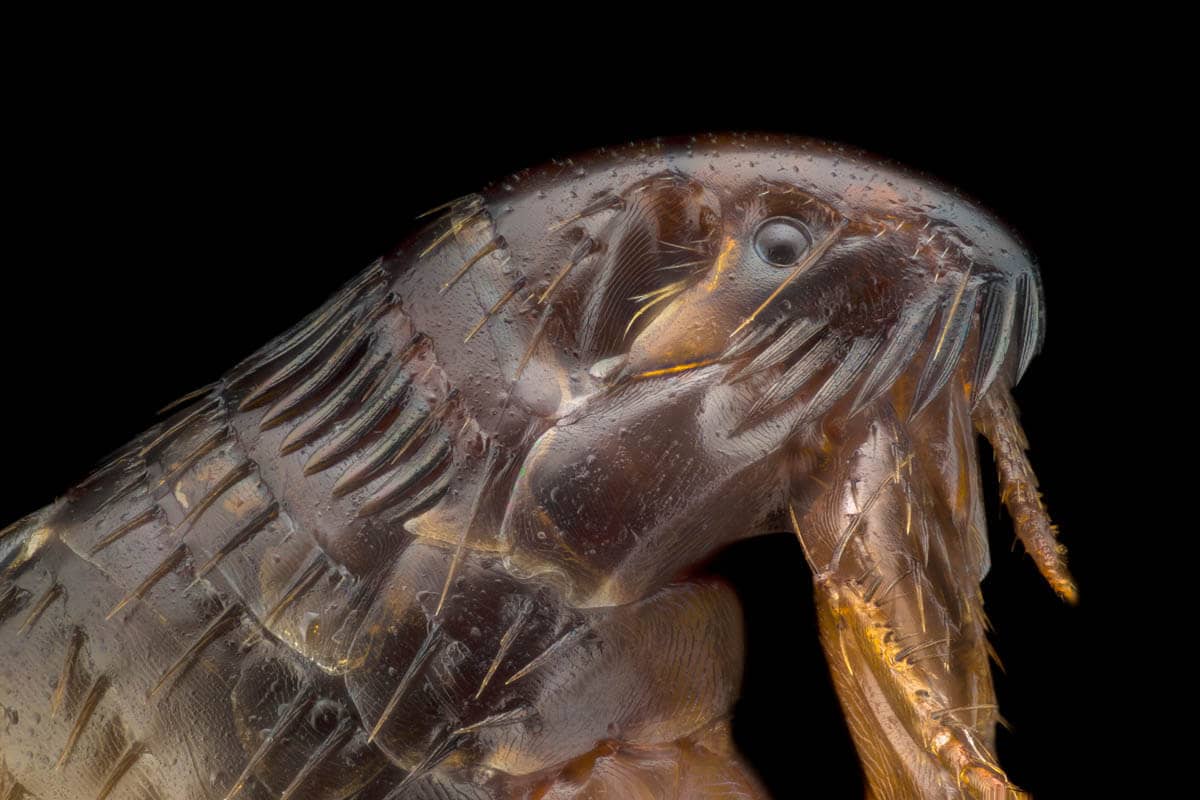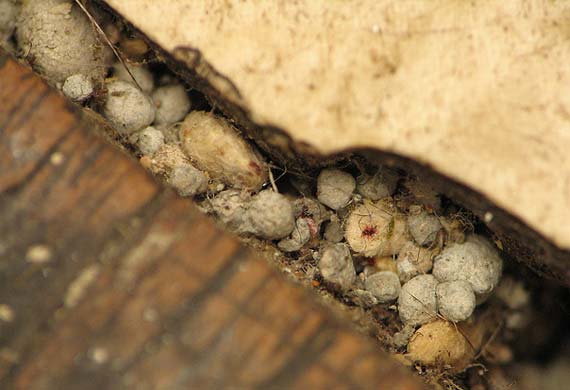Cat fleas at a glance
About: Cat fleas are a common parasite that live on the fur and skin of cats, where they feed on the cat’s blood.
Transmission: Cats become infested when they come into contact with fleas in the environment, another animal, or even when humans bring fleas inside. Fleas not only cause discomfort but can also transmit diseases, parasites and cause anemia.
Symptoms:
- Scratching
- Excessive grooming
- Crusty papules and open sores along the back and around the neck due to an allergic reaction
- Allergic reaction to the saliva, producing crusty sores on the back and around the neck
- Salt and pepper debris where the cat sleeps, which is flea eggs and feces
- Pale gums (if anemic)
Treatment: Kill adult fleas on the cat and treat the environment. Veterinary prescribed flea treatments are the most effective; they come in topical form applied to the skin on the neck or tablet form.
What are cat fleas?

Fleas are wingless parasites that feed on the blood of mammals, including cats. There are approximately 2,000 species of flea; however, Ctenocephalides felis is the most common species to feed off cats (and dogs).
They pose a significant risk to cats as they can transmit several infectious diseases as well as tapeworm, cause severe allergies in sensitive cats and heavy flea burdens can lead to anemia.
All cats are at risk, even those who are strictly indoors as fleas can hitch a ride on the clothing of household members and visitors. As well as that, flea pupae can lie dormant in the environment for up to six months.
How do I know if my cat has fleas?
- Itching, biting and scratching, especially around the neck, ears and around the base of the tail.
- Crusting papules and sores: Some cats are sensitive to the saliva in the flea bite and may develop crusting; this is particularly common along the back and around the neck.
- Salt and pepper: You may notice flea eggs and droppings in his coat or bedding. Flea eggs are white, droppings are dark red, giving the appearance of salt and pepper.
Carefully go through your cat’s fur, paying close attention to the base of the tail and around the neck. Cat fleas are brown with a flat body, and approximately 2 mm in length.
Effects of fleas on your a cat

Fleas can have a serious impact on your cat’s health and comfort. Heavy infestations can lead to anemia, particularly in young kittens who have a reduced blood supply and are less efficient groomers.

Cats can develop an allergy to flea saliva (flea allergy dermatitis), an extremely uncomfortable condition characterised by itching, biting and scratching along with multiple papules and areas of hair loss. Left untreated, repeated biting and scratching can damage the skin and lead to a bacterial infection.
Fleas transmit several diseases which include tapeworm, plague, bartonellosis, tularemia, feline infectious anemia, and rickettsia.
Life Cycle of the flea
To combat fleas, it is important to understand their life cycle. There are four stages of the flea life cycle, known as metamorphosis.

Flea stages
The graph below illustrates the number of fleas in their different life stages. Adult fleas only account for 5% of the total flea population; the other three make up larvae 35%, pupae 10% and a whopping 50% are flea eggs.
1) Adult flea:

The adult flea emerges when it is stimulated by environmental factors such as vibrations, warmth or breath of the host and can come out of its cocoon within seconds of stimulation.
Adult fleas suck blood from their host and female fleas must have a blood meal before she can lay eggs, which will occur 36-48 hours after her first meal. A female consumes up to 15 times her body weight in blood per day and can lay between 40 – 50 eggs per day.
2) Flea eggs:
At .5mm in length, flea eggs are barely visible to the human eye. The flea egg is whitish, smooth and dry, making it easy for them to fall off the coat and into the environment.
Flea eggs hatch after 1 – 10 days, depending on conditions. Pet owners may notice that flea eggs and flea droppings are often found together. When the cat scratches the eggs along with the droppings, fall off the cat.
Environmental conditions such as humidity, light, and temperature determine how quickly and how many flea larvae hatch from flea eggs. The lower the temperature, the fewer larvae will hatch. Optimal conditions for flea larvae to hatch are 70% and higher and temperatures of 21 – 32 degrees C (70 – 89 degrees F).
3) Larvae:

The larvae are vermiform (maggot-like) like in appearance and up to 6mm long, flea larvae avoid light by residing deep in carpet fibres, under furniture and in areas your cat frequents such as cat beds. At this stage, they have no legs or eyes but have chewing mouthparts. Flea larvae feed on flea eggs and adult flea feces which are composed almost entirely of dry cat blood.
If the opportunity presents, flea larvae will also eat tapeworm eggs in the environment. Once inside the flea larvae, the tapeworm larvae are released and develop into the cysticercoid form, where it remains in the flea larvae as it develops into an adult flea. The tapeworm infected flea goes on to parasitise the cat and is accidentally ingested when the cat grooms. Once inside the cat, the flea breaks apart and the tapeworm is released.
4) Pupae:

Image credit Sean McCann, Flickr
The transition stage between larvae and adult flea. After approximately 7-18 days the flea larvae pupate. It takes approximately 7 – 10 days for the larvae to develop into a flea, although it may be some time before the flea emerges from its protective cocoon. They are at their most resilient as pupae, and resistant to insecticides.
The flea larvae spin a sticky, protective silken (produced by the saliva of the larvae) outer cocoon, covered with particles of debris such as dust, hair, lint etc. The pupae are found in carpet fibres, crevices etc., and are virtually undetectable.
Can I catch fleas from my cat?
A heavy infestation may lead to fleas taking the occasional blood meal from humans, but they generally prefer to live on cats. Signs you may have been bitten by a flea include itching and scratching and a small, red, papule. Humans are most often bitten around the ankles and feet.
Treatment options
Because only 1% of the flea population is actually on the cat, it is necessary to treat both the cat and the home at the same time.
There are many products available to treat fleas on cats. Flea collar, shampoo, flea combs, spray, tablets, powders, insect growth regulators and topical treatments. The most effective products are spot-on or oral suspension treatments which are available from your veterinarian. Fleas can develop a resistance to some products, speak to your vet for his advice on the most effective flea control treatment.
Flea collars
There are many different types of flea collar on the market. Some are insecticide only and work by killing adult fleas on the cat. Other flea collars contain IGR’s to kill the eggs and larvae.
Flea collars often only kill fleas on the cat’s head and neck, but fleas further down the body survive.
Shampoos and dips
There are many different types of flea collar on the market. Some are insecticide only and work by killing adult fleas on the cat. Other flea collars contain IGR’s to kill the eggs and larvae.
Flea Combs
Flea combs aren’t overly effective, only removing 10 – 50% of fleas on your cat. If you wish to use this method, place a small bowl of water with some detergent in it close by and drop the fleas into the bowl. This will drown the fleas. Placing a small amount of petroleum jelly onto the teeth of the comb will help the fleas stick to it.
Flea Powders
Flea powders will kill adult fleas on the cat. Powders may cause the cat’s coat to dry out and also may be irritating to the cat’s oral and respiratory mucosa.
Flea medications
| Tablets |
|
| Topical solutions |
|
| Sprays |
|
| Injection |
|
| Oral suspensions |
|
Flea product safety
- When applying a flea product to a cat, it is important to follow the instructions on the packet to the letter. Cats are extremely sensitive to chemicals, and if you are using one than one product, your cat may be exposed to too many toxins, resulting in sickness or death.
- Rotating flea products can help increase effectiveness as fleas are becoming resistant to some flea control products.
- After administering flea products, closely observe your cat for adverse reactions.
- Warning: Never administer dog flea products to a cat.
Natural cat flea repellents
- 50 ml apple cider vinegar
- 50 ml water
Mix in a spray bottle, spray onto your hands and stroke into your cat’s coat as well as on your cat’s bedding and other areas your cat frequents. You can also add two drops of catnip essential oil to increase effectiveness.
Food-grade diatomaceous earth can be applied to floors, bedding, and your cat’s coat. Avoid the head and face as it can be irritating if inhaled.
Remove fleas by hand using a flea comb. This is a good method, especially when removing fleas from young kittens (under 6 weeks of age) who are too young for most chemical flea products. When removing fleas, flick them into a bowl of hot soapy water to drown them.
A word of caution when using natural cat flea products
Always be careful with essential oils on or around cats. Remember, these oils are concentrated and many are toxic to cats even in low doses. I frequently see people advising the use of tea tree oil as a natural flea treatment, but this is toxic unless diluted to 0.1-1%. So avoid where possible, or use with extreme care and only at a safe dilution.
Do not use garlic, which is toxic to cats.
Treat the environment
Vacuum:
Vacuum daily to remove fleas and their eggs. Buy a flea collar, cut it into pieces and put a piece in your vacuum cleaner bag.
Pay extra attention to corners, skirting boards, under furniture and any other nooks and crannies. Once you have vacuumed, clean out the bag and dispose of it carefully. Ensure that every time you vacuum, you empty the bag or canister to prevent any fleas from escaping.
Better still, use a steam cleaner to kill flea eggs and larvae in the home.
Insect foggers:
To treat the house and environment, you can either hire the services of a professional pest controller or buy a product from your local supermarket. Most DIY products come in the form of an aerosol bomb. Insect foggers kill adult fleas only.
Remove animals before bombing as foggers are toxic to other animals (including fish).
IGR’s (insect growth regulators):
These sprays disrupt the cycle of the flea. They prevent eggs from hatching, kill larvae and prevent adult fleas from reproducing. These most often come in as a bomb/spray and can be used on carpets and furniture.
A pest controller should be able to spray your house and garden for fleas. It is important to specify that you have cat(s) living in the house, so they can use a suitable spray that is safe for pets.
Wash rugs, cat bedding, etc., in the hottest possible cycle. You can also spray unwashable bedding with flea sprays such as Frontline.
Treat outdoors:
Spray areas your pet tends to hang out, and if he has bedding in the garden, bring it in and wash it.
You will need to flea bomb any outdoor buildings such as garages and sheds, especially if your cat hangs out there.
Keep woodpiles stacked and away from your home.
Long term flea control
- Regular application of a good quality flea control on your cat is the best method of flea control.
- Vacuum regularly and pay close attention to skirting boards and around areas your cat eats and sleeps.
- Cover the cat’s bedding with soft towels or blankets and wash in a hot cycle regularly.

